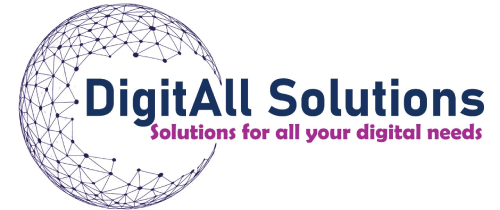 The future is brimming with possibilities thanks to Generative AI. Imagine this powerful technology crafting catchy tunes, generating compelling marketing copy, or even designing a groundbreaking bridge – all at your command! But with great power comes great responsibility. Just like any powerful tool, Generative AI needs careful handling to ensure it’s used ethically, securely, and doesn’t pose a threat to cybersecurity.
The future is brimming with possibilities thanks to Generative AI. Imagine this powerful technology crafting catchy tunes, generating compelling marketing copy, or even designing a groundbreaking bridge – all at your command! But with great power comes great responsibility. Just like any powerful tool, Generative AI needs careful handling to ensure it’s used ethically, securely, and doesn’t pose a threat to cybersecurity.
In this guide, we’ll leverage insights from DigitAll Solutions’ leading experts in the field of artificial intelligence to be knowledgeable about the five key steps for securing Generative AI. This approach ensures you have access to the most up-to-date knowledge and best practices:
1. Building a Trusted Environment: Minimizing Data Loss
Think of your data as the blueprints for your AI’s creations. They’re vital, so keeping them safe is paramount. Here’s how to build a trusted environment:
- Data Security & Encryption: Imagine impenetrable encryption as a high-tech vault. It scrambles your training data, making it unreadable without the key. This ensures the privacy and security of the information used to train your Generative AI model.
- Access Controls: Not everyone needs access to the blueprints, right? Limit access to your training data based on user roles and permissions. This minimizes the risk of unauthorized access and potential misuse also with respect to cybersecurity.
- Regular Backups: Just like having a spare set of keys, maintain regular backups of your data in case of unforeseen incidents. This ensures business continuity and protects your valuable information in the event of a data loss event.
2. Training Your Team: Preparing for the Future
Generative AI is a team effort. Just as soldiers train for battle, equip your employees with the knowledge to use and safeguard this technology. Here’s how to get them started:
- Security Awareness Training: Educate your team on potential security risks associated with Generative AI. This could include topics like data breaches, adversarial attacks, cybersecurity threats and the potential for bias in outputs. By raising awareness, you empower your team to identify and mitigate these risks.
- Clear Guidelines and Policies: Develop clear guidelines on how to use Generative AI responsibly and ethically. These guidelines should cover aspects like data privacy, acceptable use cases, and potential limitations of the technology. Having a clear framework ensures everyone is on the same page and minimizes the risk of misuse.
Contact DigitAll Solutions for free consultation on Cybersecurity services.
3. Transparency is Key: Sharing What You Know
Transparency builds trust. Be open about the data you use to train your generative AI model. Here’s how:
- Data Provenance: Track where your data comes from and ensure it’s ethically sourced. Knowing the origin of your data helps identify potential biases and ensures responsible data practices.
- Explainability Tools: Develop tools that explain how your AI arrives at its outputs. This fosters trust and understanding by demystifying the decision-making process of your Generative AI model. Users can then better evaluate the generated content and make informed decisions.
4. Human-AI Collaboration: Countering “AI for Bad”
Imagine a knight and a powerful steed working together. That’s the ideal human-AI partnership. Here’s how to stop AI from being misused:
- Human Oversight: Humans should always oversee the outputs of Generative AI, ensuring they align with your ethical guidelines. This human oversight acts as a safeguard against cybersecurity threats, potential biases or unintended consequences in the generated content.
- Bias Detection and Mitigation: Be proactive in identifying and mitigating potential biases in your training data to prevent discriminatory outputs. Techniques like data cleaning and bias correction algorithms can help ensure your Generative AI is fair and unbiased.
5. Understanding Model Risks: Staying Ahead of the Curve
Just as castles need constant upkeep, so do AI models. Here’s how to stay vigilant:
- Vulnerability Testing: Regularly test your AI model for vulnerabilities to identify and patch them before they’re exploited. These vulnerabilities could allow attackers to manipulate the model’s outputs or steal sensitive information. Proactive testing helps maintain the integrity and security of your Generative AI.
- Monitor for Misuse: Keep a watchful eye on how your AI is being used. If you suspect misuse, take action to stop it. This could involve implementing user monitoring tools or establishing clear reporting procedures for potential misuse cases.
Generative AI Security is an Ongoing Journey
Think of securing Generative AI as building a magnificent castle. Just as a medieval fortress required constant vigilance and adaptation to withstand new threats, so too does a secure generative AI system. Emerging technologies and evolving tactics by malicious actors necessitate a continuous process of improvement. By following these five steps, you’ll lay a strong foundation for your AI’s security. However, the journey doesn’t end there. Staying informed about the latest threats and vulnerabilities is crucial for maintaining a robust defense. Imagine vigilant guards on the castle walls, constantly scanning the horizon for potential danger to cybersecurity. By adopting this proactive approach, you can ensure your Generative AI remains a force for good, shaping a brighter future for your organization.
At DigitAll Solutions, we understand the complexities of implementing and securing cutting-edge technologies like Generative AI. Our team of experts can help you navigate these challenges. We offer comprehensive security audits, customized training programs for your team, and ongoing monitoring to ensure your Generative AI is operating at its peak performance while adhering to the highest ethical standards. Contact DigitAll Solutions today to harness the full potential with complete peace of mind.





